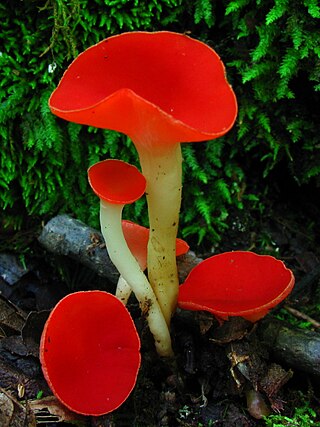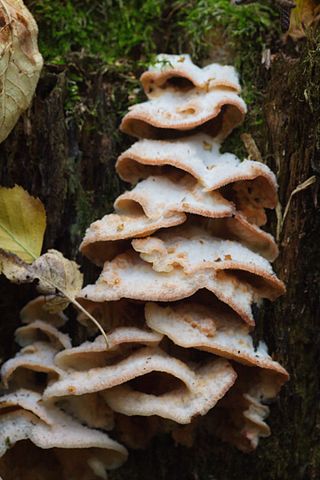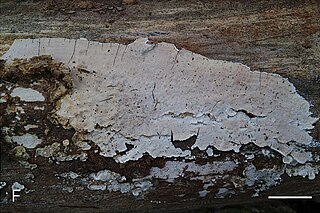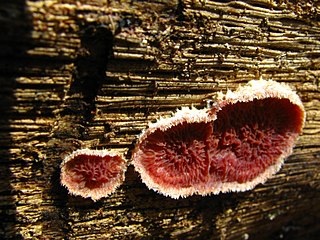
Amanita porphyria, also known as the grey veiled amanita or the porphyry amanita, is a fairly common, inedible mushroom of the genus Amanita found in Europe and North America.

Lewis David de Schweinitz was a German-American botanist and mycologist from Bethlehem, Pennsylvania. Considered the "Father of North American Mycology," he also made significant contributions to botany.

Peniophora albobadia is a species of crust fungus in the family Peniophoraceae. It is a saprobic fungus, forming spreading crusts on the bark of decaying twigs and fallen branches of many hardwood species. The species epithet is derived from albo-, white, and badi- meaning reddish-brown, the epithet accurately describing the vivid contrast between the fertile area and the margin.
Rhytisma vitis is a species of fungus in the family Rhytismataceae. It was described by Lewis David de Schweinitz in 1832.

Terana caerulea, commonly known as the cobalt crust fungus or velvet blue spread, is a saprobic crust fungus in the family Phanerochaetaceae. Usually found in warm, damp hardwood forests on the undersides of fallen logs and branches of deciduous trees, this unique fungus has been described as "blue velvet on a stick". This species was chosen as fungus of the year for 2009 by the German Mycological Society.

Cantharellus lateritius, commonly known as the smooth chanterelle, is a species of edible fungus in the mushroom family Cantharellaceae. An ectomycorrhizal species, it is found in Asia, Africa, and North America. The species has a complex taxonomic history, and has undergone several name changes since its first description by American mycologist Lewis David de Schweinitz in 1822. The fruit bodies of the fungus are brightly colored yellow to orange, and usually highly conspicuous against the soil in which they are found. At maturity, the mushroom resembles a filled funnel with the spore-bearing surface along the sloping outer sides. The texture of the fertile undersurface (hymenium) of the caps is a distinguishing characteristic of the species: unlike the well-known golden chanterelle, the hymenium of C. lateritius is much smoother. Chemical analysis has revealed the presence of several carotenoid compounds in the fruit bodies.

Sarcoscypha occidentalis, commonly known as the stalked scarlet cup or the western scarlet cup, is a species of fungus in the family Sarcoscyphaceae of the Pezizales order. Fruit bodies have small, bright red cups up to 2 cm (0.8 in) wide atop a slender whitish stem that is between 1 and 3 cm long. A saprobic species, it is found growing on hardwood twigs, particularly those that are partially buried in moist and shaded humus-rich soil. The fungus is distributed in the continental United States east of the Rocky Mountains, Central America, the Caribbean, and Asia. It is distinguished from the related species S. coccinea and S. austriaca by differences in geographical distribution, fruiting season, and fruit body structure. Phylogenetic analysis has shown that it is most closely related to other Sarcoscypha species that contain large oil droplets in their spores. The species Molliardiomyces occidentalis is an imperfect form of the fungus that lacks a sexually reproductive stage in its life cycle.

Galiella rufa, commonly known as the rubber cup, the rufous rubber cup, or the hairy rubber cup, is a species of fungus in the family Sarcosomataceae. The fungus produces cup-shaped fruit bodies that typically grow in clusters on branches and exposed portions of buried wood throughout eastern and Midwest North America and in Malaysia. The fruit bodies have the texture of tough, gelatinous rubber, and have a rough, blackish-brown, felt-like outer surface and a smooth reddish-brown inner surface. Although generally considered inedible by North American mushroom field guides, it is commonly consumed in Malaysia. The fungus produces several interesting natural products.

Boletinellus merulioides, commonly known as the ash-tree bolete, is a species of bolete fungus in the family Boletinellaceae. Described as new to science in 1832, it is found in Asia and eastern North America, where it grows on the ground near ash trees.

Lentinus strigosus is a species of fungus in the family Polyporaceae. It is edible when young, but becomes very tough with age.

Phlebia incarnata is a species of polypore fungus in the family Meruliaceae. It is inedible.

Multiclavula vernalis or the orange club-mushroom lichen is a species of clavarioid fungus in the Clavulinaceae family. It was originally named as a species of Clavaria in 1822 by Lewis David de Schweinitz. Ronald H. Petersen transferred it to Multiclavula in 1967.

Polyporus radicatus is a species of fungus in the family Polyporaceae. It was described as new to science by German-American botanist Lewis David de Schweinitz in 1832. It is found in North America, including Mexico. It grows on the ground, probably from buried roots or originating from sclerotia. Its spores are more or less ellipsoid to spindle shaped, measuring 12–15 by 6–8 µm. It is inedible.

Phlebia centrifuga is a species of crust fungus in the family Meruliaceae. It was described in 1881 by Petter Karsten.

Sarcodontia crocea is a species of toothed crust fungus in the family Meruliaceae. The species was first described scientifically in 1822 by Lewis David de Schweinitz, who called it Sistotrema croceum. It was transferred to the genus Sarcodontia by Czech mycologist František Kotlaba in 1953. S. crocea usually occurs on old fruit trees, in which it causes a white rot. It is found in Europe, Asia, and North America. It is red-listed in several European countries.

Datroniella scutellata is a species of fungus in the family Polyporaceae, and the type species of genus Datroniella.

Phlebia tremellosa, commonly known as trembling Merulius or jelly rot, is a species of fungus in the family Meruliaceae. It is a common and widely distributed wood-decay fungus that grows on the rotting wood of both hardwood and conifer plants.

Lopharia cinerascens is a species of crust fungus in the family Polyporaceae. It was first described by botanist Lewis David de Schweinitz in 1832 as Thelephora cinerascens. Gordon Herriot Cunningham transferred it to Lopharia in 1956. It is widely distributed in Africa, Asia, Australasia, and North America; it is less common in Europe and South America.
Anixia interrupta is a species of fungus belonging to the Anixia genus. It was documented in 1832 by German-American mycologist Lewis David de Schweinitz.

Punctularia strigosozonata is a fungus species of the genus Punctularia. It was originally described in 1832 by Lewis David de Schweinitz as a member of genus Merulius. Patrick Talbot transferred it to genus Punctularia in 1958. Punctularia strigosozonata produces the antibiotic phlebiarubrone.


















